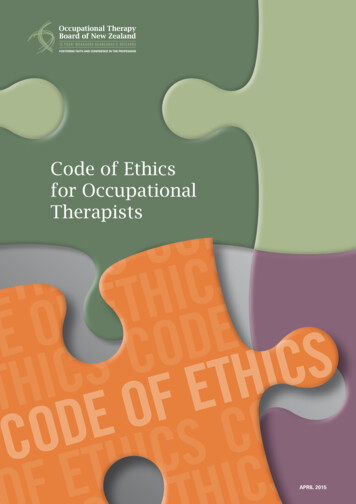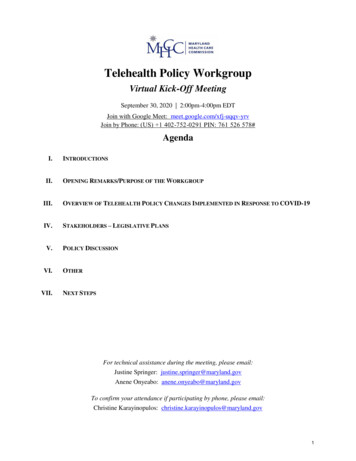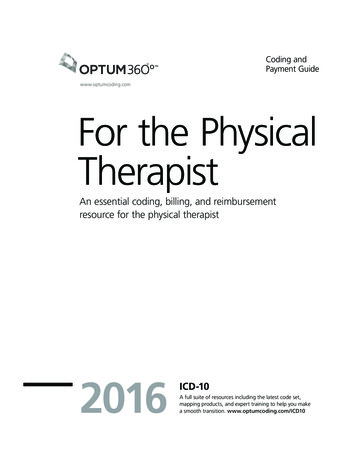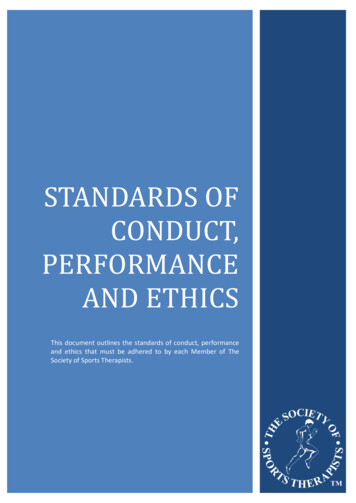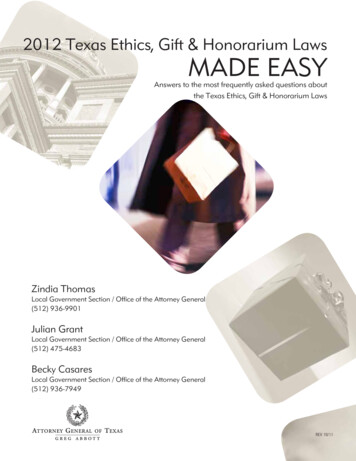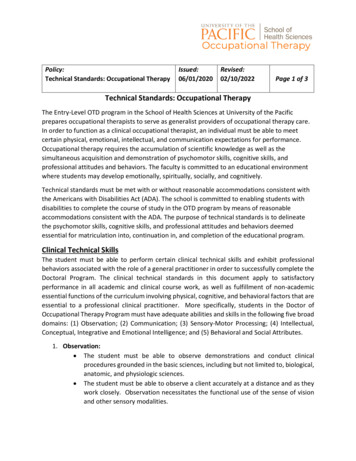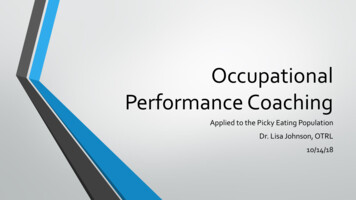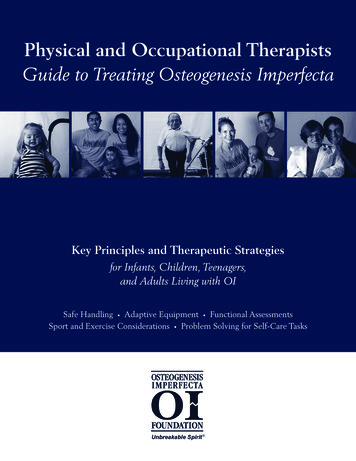
Transcription
Physical and Occupational TherapistsGuide to Treating Osteogenesis ImperfectaKey Principles and Therapeutic Strategiesfor Infants, Children, Teenagers,and Adults Living with OISafe Handling Adaptive Equipment Functional AssessmentsSport and Exercise Considerations Problem Solving for Self-Care Tasks
ContentsWhat is Osteogenesis Imperfecta (OI)? . 3Major Types of OI . 4 – 5The Role of Physical and Occupational Therapy in Managing OI . 6 – 8Key Principles of Therapeutic Strategies for Osteogenesis Imperfecta . 9 – 20Skills Progression . 9Developmental Progression Chart for Children with OI . 10Protective Handling . 12Safe Handling of Infants and Young Children with OI . 12Safe Handling of Older Children and Adults with OI . 12Preventive Positioning . 13Active Movement . 13Water Therapy . 14Adaptive Equipment and Aids to Independence . 15Reduction of Fracture Risk . 15Mobility . 15Accessibility . 15Commonly Used Adaptive Equipment Chart . 16 – 19Encourage Healthy Living . 19Strategies for Evaluation and Functional Assessmentof Teens and Adults with OI . 20 – 22Problem Solving for Specific Self-Care Tasks . 23 – 24Strategies: Exercise and Fitness for Teens and Adults with OI . 25Specific Exercise and Sport Considerations for People with OI . 26Summary: Strategies for Physical and Occupational Therapy . 27References . 28Equipment Sources and Wheelchairs . 292Physical and Occupational TherapistsGuide to Treating Osteogenesis Imperfecta
What is Osteogenesis Imperfecta (OI)?Osteogenesis imperfecta (OI) is a rare, complicated andvariable disorder. Its major feature is a fragile skeleton, butmany other body systems are also affected. OI is caused bya mutation (change) in a gene that affects bone formation,bone strength and the structure of other tissues. OI can beinherited from a person’s parents in an autosomal dominantmanner or occur via a new mutation in a gene that affectsbone formation, bone strength, and the structure of bodytissues containing collagen. OI occurs equally among malesand females and in all racial and ethnic groups. It is estimatedthat approximately 25,000 to 50,000 people in the U.S haveOI. The incidence of OI is approximately 1 in 15-20,000live births.People with OI experience broken bones from infancythrough puberty. The frequency typically decreases inthe young adult years but may increase again later in life.Respiratory problems including asthma are often seen. Shortstature, rib cage deformities and spine curves make breathingproblems more severe.Other common medical characteristics and issues include: Bone deformity, and bone pain Hearing loss (present in more than 50% of people with OI) Brittle teeth (dentinogenesis imperfecta or DI) are seen in 50% of people who have OI Vision problems including myopia and risk for retinal detachment Loose joints, ligament laxity, and muscle weakness are common Cardiac issues Basilar Invagination (seen in some people with more severe forms of OI)OI exhibits wide variation in appearance and severity. Severity is described as mild, moderate,or severe. The most severe forms may lead to early death. Clinical features (observable signs)vary widely not only between types, but within types, and even within the same family. Somefeatures are age dependent. Children with milder OI, in particular, may have few obviousclinical features. Since the 1970’s a list of numbered types has been used to describe thedifferent forms of OI.Key Principles and Therapeutic Strategies3
Major Types of OIBelow are some of the distinguishing features of the major types of OI.Type I (Mild) Most common and mildest type of OI; few obvious clinical signs Typical or near-normal height versus age-matched peers and unaffected family membersType II (Most Severe) Infants may die within weeks from respiratory or heart complications Numerous fractures and severe bone deformity are evident at birth Small stature with underdeveloped lungs, and low birth weightType III (Severe) Progressive bone deformity is often seen in long bones Fractures are present at birth, and x-rays may reveal healed fractures that occurredbefore birth Short stature Barrel-shaped rib cage Spinal curvature and compression fractures of vertebrae Triangular facesType IV (Moderate) Between Type I and Type III in severity and height Mild to moderate bone deformity Spinal curvature and compression fracture of vertebrae Barrel-shaped rib cageType V (Moderate) Similar to Type IV in appearance and symptoms of OI Large hypertrophic calluses form at fracture or surgical procedure sites Calcification of the membrane between the radius and ulna restricts forearm rotation4Physical and Occupational TherapistsGuide to Treating Osteogenesis Imperfecta
Type VI (Moderate) Extremely rare; similar to Type IV in appearance Distinguished by a characteristic mineralization defect seen in biopsied boneType VII (Severe) Recessive inheritance Phenotype is moderate to severe Rhizomelia (disproportional usually shorter proximal bone)Type VIII (Very Severe) Similar to Type II but with recessive inheritance Severe growth deficiency and under mineralization of the skeletonFor a detailed list of OI Types including clinical signs, degree of severityand mutation, please see the OI Foundation’s Medical Education websitewww.oif.org/meded.Key Principles and Therapeutic Strategies5
The Role of Physical and OccupationalTherapy in Managing OIWhen working with individuals and families living with OI, therapists should keep theseprinciples in mind: Listen. It is essential to listen to individuals with OI and their families and respect theirinput. Individuals and families are truly the experts on how OI affects them. Listening totheir concerns and ideas, building on their strengths and interests, and working with them asa team will help ensure success. They have excellent solutions that you can share with otherclients with OI. Set Goals. Make goals incremental, realistic and achievable. A successful plan of careincludes the individual with OI and the family’s personal goals. Weakness is a significant constraint to movement in OI. It is critical to remember thatpeople with OI do not have impaired coordination, sensation or cognition and do notrequire the complex, neurologically based interventions used for people who do. Fear of Fractures is another serious constraint to movement. Establishing safe movementprocedures, encouraging self-confidence and optimizing strength are strategies that can helpresolve this issue. Passive range of motion is not recommended with new clients. Expect Success. With the proper environment and equipment, the majority of childrenand adults with OI can function well in many or most areas of daily life including but notlimited to self-care, school and work.The long-term goal for people with OI is independence or interdependence in all lifefunctions with adaptive devices as needed at home, at school, in the workplace and inthe community. In the case of very severely affected people, the goal becomes the abilityto direct their own care.Physical and occupational therapy are part of an interdisciplinary approach to treatment. Themedical team may also include a primary care physician, orthopedist, geneticist, nutritionist,social worker, and psychologist. Children and adults with OI, especially those with spine curveswhich may affect pulmonary status, may regularly see a pulmonologist. Ideally planning aheadfor rehabilitation is included in the preparation for surgery.Maximizing a person’s strength and function not only improves overall health and wellbeing, but also improves bone health, as mechanical stresses and muscle tension on bone helpincrease bone density. For example, deformities such as a flattened skull, a lordotic back, or tighthip flexor muscles can be prevented or minimized through therapy.6Physical and Occupational TherapistsGuide to Treating Osteogenesis Imperfecta
Approaches include: Exercise and recreational activities including weight bearing activities (braces may beneeded), and low-impact activities such as swimming, once precautions are defined. Safe handling and encouraging different body positions and postures during the day tostrengthen muscle groups and prevent deformities. Adaptive equipment. The individual with OI may need a variety of mobility aidesdepending on the environment (cane, walker, manual or power wheelchair). Environmental adaptations to the home, school or workplace.Circumstances requiring intermittent or long-term physical and occupational therapy will includethe following:When a child with OI has delays or weakness in motor skillsBecause of fractures, immobilization due to fracture, muscle weakness, and joint laxity,many children with OI (even those who are mildly affected) experience delays in motorskill development, which then interfere with function and participation in peer andfamily centered activities. Large and small muscle groups may be affected. Therapy topromote achievement of developmental milestones should begin as soon as it is evidentthat an infant has muscle weakness or motor skill delay when compared with sameage peers, and continue until a child reaches appropriate child/family centered therapygoals. The therapist often needs to address how muscle imbalances from bowing and/ormuscle weakness affects forces across bones, postural alignment and movement. In somecases, an infant or young child may have delays, but after gaining sufficient strength, willbe able to sit, stand, and walk. In other cases, certain motor skills may be unattainabledue to weakness or skeletal deformities. For example, walking is not possible for somepeople with OI. When this is the case, the therapist works with the person to maximizefunction by developing other skills, and using adaptive equipment, energy conservation,and joint protection concepts. Fine motor skills can be delayed or diminished and makehandwriting, typing, and using hand tools difficult.When a child or adult with OI is recovering from a fracture, surgery or injuryBecause fractures and surgery are frequent for many people with OI, it is particularlyimportant for them to regain as much function as quickly as possible during recovery. Itis beneficial to maintain strength in limbs that are not affected by the fracture or surgery.The therapist can work with the individual with OI during periods of fracture, surgery orinjury to minimize the detrimental effects of immobilization such as decreased musclemass, weakness, fear of movement or learned helplessness. Minimize immobilizationtime with physician approval. After recovery, additional intensive rehabilitation is oftenneeded to assist relearning previously mastered skills, or to regain strength in the affectedlimb(s). Repetitive movement injuries are common among adults who have OI who useKey Principles and Therapeutic Strategies7
mobility aids. Hands, wrists, shoulders and knees are often affected. The therapist canhelp the client develop alternate strategies, and learn to use appropriate equipment suchas sliding boards to make self-care skills easier.When a person with OI experiences fear of movement and trying new skillsand activities.In some cases, the biggest obstacle to independent function is fear. Children and adultswho have had fractures may become fearful of moving or trying new things. Parentalfears and concerns can complicate the situation. In some families, these fears can leadto the child’s complete dependence on a parent for all aspects of daily function andself-care. Therapists must acknowledge these fears as understandable, but also suggestways that new skills can be practiced in a safe environment. A successful strategy isbreaking skills down into small, achievable steps. This allows the individual to succeedat something relatively easy and progress step by step until the skill is mastered.Encouraging active movement within a self-care activity can be both a strengtheningexercise as well as empowering to the individual by engendering an “I can do it” attitude.Additional approaches include positioning, active movement, water therapy and the useof protective equipment (e.g., clamshell style ankle foot orthosis, or forearm supportson walkers). Encouraging the child to direct some of his or her own care, transfers, andhandling will also build the child’s confidence. This can start with family members,friends and teachers.When a person with OI reaches a transition point in life, they must adapt to anew environment or require ADL training.Many key activities of daily living—such as toileting, dressing, bathing, grooming,doing laundry and preparing food—pose challenges to people with OI. Some maylack the strength to perform certain tasks, or have trouble using standard householdequipment because they are short-statured or use a wheelchair. Due to injury, aging, orprogressive deformity, children and adults with OI often have to relearn how to do atask in an entirely different manner. Changes in the person’s environment – attendingday care, changing schools, moving out of the parental home, or new employment –may necessitate learning a new skill or improving stamina. Through a combination ofstrengthening activities, use of adaptive equipment, and creative problem solving, manyobstacles to independent self-care can be overcome.8Physical and Occupational TherapistsGuide to Treating Osteogenesis Imperfecta
Key Principles of Therapeutic Strategiesfor Osteogenesis ImperfectaPatience and task analysis are both necessary todevelop a successful therapy program. Therapy mayprogress more slowly for individuals with OI thanfor other therapy patients. Developmental conceptsand specific skills need to be analyzed closely, so thatmany small improvements can lead to achieving aparticular therapy goal. Key therapeutic strategiesinclude the following.1. Skill Progression - before learning personal careskills, a child must first develop gross motorskills such as reaching and sitting, which may bedelayed or difficult for those with moderate tosevere OI. Adults may need to relearn a series ofskills after a serious injury.2. Protective handling, preventive positioning, andactive movement with gradual progression contribute to safe development of motor skills.3. Water therapy provides the opportunity for children with OI to develop skills in a reducedgravity environment before trying them on land. Adults often use water therapy to relearnor maintain motor skills. Water is a great place to start getting past the fear of movement.4. Equipment, ranging from simple pillows to specialized wheelchairs, can help children andadults achieve motor and personal care goals even if they have weakness or are recoveringfrom a fracture.5. Encouraging healthy living is an important part of the therapeutic relationship. Promotinggeneral health, preventing obesity, and encouraging participation in recreational activities areimportant elements of achieving the goal of a lifestyle of wellness and greater independence.Skills ProgressionMeeting developmental milestones is challenging for many children who have OI. Some willnot be met, but they can be compensated for by building related skills. For example, a particularchild might not be able to crawl, but may develop other methods of floor mobility such assnaking or bottom scooting. A skate or scooter board can be used to eliminate the pull of gravityand encourage mobility. Introduce new positions and skills gradually to allow the person tofeel safe as well as to promote gradual strengthening of muscles and bones. Provide adequatesupport to overcome weakness and prevent injury. See the Developmental Progression ChartKey Principles and Therapeutic Strategies9
for Children with OI for more details. Older children and adults will need a similar progressionof skills to learn or relearn activities of daily living.Developmental Progression for Children with OI (Chart)ProgressionPossible Modifications Needed for People with OISupine PositioningProvide frequent position changes (side lying) to prevent flat skull andarm/leg contractures. Keep arms/legs positioned with proper alignmentto head/trunk to prevent tightness across the shoulders/elbows/hip/knee/ankle regions. If child cannot get hands to midline, use troughshaped foam bed pad or small foam wedges to guide shoulders forward.Side LyingMay need support under head and below axilla. Excellent position forinfants; promotes hands to midline and relieves flattening of skull.Prone PositioningUse a small roll under the armpits to facilitate baby lifting his/her head;practice on parent’s chest first. Be aware that many babies with OI dueto barrel chest dislike prone position. However, even short periods inprone (2-5 minutes) are therapeutic.Inclined SittingBlanket rolls along torso for support can also serve as arm rests. Positionthe child to decrease wide hip abduction and external rotation. Provideplace for feet to rest flat. Use very wide straps or vest for trunk support.RollingMay not be comfortable for child. Start using blanket like a hammockand slowly tilt child, or position child to reach for a ball or object. Thentry partial rolling in a blanket on a firmer surface. Once child is able totolerate side motion, use slight wedge to roll downhill.Supported SittingMay be done in infant car seat or positioning chair as with inclinedsitting (above). Provide head and neck support at first. Slowly decreasesupport as head turning gets better and slowly decrease recline. Properhead, trunk, and pelvic alignment are encouraged. Firm infant seats, carseats, and rockers are recommended to provide a stable base of supportand avoid a flexed spine posture.10Physical and Occupational TherapistsGuide to Treating Osteogenesis Imperfecta
Unsupported SittingStart with ring sitting. Use corner sitting or nursing pillow initially.Once head and trunk control present, work toward sitting on a chair orbench with hips, knees, ankles at 90 degrees or short sitting (with closesupervision). Due to bowing, arm length can be shortened in relation tothe trunk; therefore, an infant or child’s protective reactions of the armsto stop a fall when sitting can be inefficient. Use nursing pillows aroundinfant or corner sitting for elevated support to the arms.Achieving SittingStart in the pool with child beside the parent and side-leaning on theparent’s thigh; then try to get to a sit. On land, side-lie on a wedge orpillow or parent/therapist thigh and forearm (not extended wrist). Foradults, work on abdomen strength to use a sit-up method.Sit-pivot, sit-scootStart sitting on bench in pool/tub with water to chest height and shiftside-to-side to get floating toy. Lower height of water until water ischild’s hip height. Then try on land on slippery mat. This position willbe a transfer method from chair to bed to toilet during fractures and iflegs are not strong enough to stand.CrawlingStart in kneeling position with chest supported by partially inflatedbeach ball and aim up hill on wedge. Start static reaching for toy abovechild. Progress to less chest/abdomen support. If laxity present and legsabduct, use “mermaid suit” of stretchy 6- to 8-inch wide tubigrip, oldpanty hose top or wide stockinet from child’s waist to ankles. Considera modified skate or scooter board with necessary padding and safetystrap/support.Kneeling/Pulling toStandHigh kneel for trunk development. In the pool or on land, progressfrom high kneel to half kneel. Also in pool (water depth to waist whenstanding), lower to sitting and stand up again. Then try crawling inwater the height of child’s knees.Some people with OI will achieve all of these skills, although interruptions in progress andreverting to previous skills are common because of fractures and surgery. Others will achieveonly some of these skills. However, supplemented by equipment and environmental adaptations,any level of proficiency with these skills will increase potential for independent functionand self-care.Key Principles and Therapeutic Strategies11
Protective HandlingThere are some basic principles of safe handling that are important to follow any time a therapistis working with someone who has OI. Fractures can occur simply because a part of the body wasslightly twisted, pushed, pulled, or compressed. People with OI and their caregivers have extensiveknowledge of what handling practices are safe for their individual cases. They should beencouraged to tell others in new situations that they are trained in safe handling to prevent injury.Safe Handling of Infants and Young Children with OI A sk the parents of infants with OI to demonstrate thesafe handling techniques they have developed. It is oftenpreferable to have the parent or caregiver do the handlingat the beginning of a therapy relationship. Graduallyover time, move into the therapist demonstratingspecific techniques. N ever pull, push, or twist a limb. Be very cautious withany passive rotation of the arms, legs, head or trunk. L ift an infant with OI with the widest base possible.Scoop the child up by placing one open hand underneaththe buttocks and legs, and the other under the shoulders,neck and head. Do not lift the child from underthe armpits which puts pressure on fragile ribs andloose shoulders. D o not lift the buttocks by pulling on the ankles, especially during diapering. Considerscooping or side lying as an option. Use loose fitting clothing. Be aware of where the child’s arms and legs are at all times to avoid awkward positions orgetting a hand or foot caught in clothing or equipment. As soon as possible, encourage the family to let the child with OI assist with any of thepositioning activities.Safe Handling of Older Children and Adults with OI Explain each new movement. Before handling the person or moving a limb, state what youare going to do and how you are going to do it. Ask them how they normally perform anaction. If they ask you to stop, stop! For young children, using a floppy doll to demonstrate amotion and to problem solve with the parent will make new transitions easier. Construct the environment to help the client achieve the task rather than using externalcaregiver hands-on assistance. Encourage clients to engage in analyzing tasks.12Physical and Occupational TherapistsGuide to Treating Osteogenesis Imperfecta
Provide adequate support for the child or adult new to the standing position to minimizebuckling and/or risk of fracture of the legs. Avoid positions and motions of great leverage that stress curved or bowed bones such as thepelvis, femur, tibia or spine. Examples of these positions include the following: The “jack-knife” position when the person leans far forward while sitting stresses the hip. The “bridging” exercise (lifting the buttocks with knees flexed while lying on the back)which stresses the tibia in the same plane in which they tend to bow. “Straddle sitting” over an adult’s thigh. This stresses the femur at the same plane in whichthey tend to bow and can also lead to imbalances in the muscles of the hip. Avoid diagonal trunk rotation which stresses the spinal vertebrae and the ribs.Preventive PositioningA key method for helping a person with OI maximize strength and function is to encouragethem to adopt various positions throughout the day, or, in the case of an infant or young child,to encourage parents and other caregivers to place the child in different positions. Positionchanges not only strengthen different muscle groups, but also help prevent contractures anddeformities that can limit mobility and increase pain. It is important to keep the hips and spineas aligned as possible, limit amount of time in supine to prevent flattening of the back of thehead, and promote active head turning in both directions.In many cases, everyday objects can be used to make different positions easier and safer. Forexample, towel rolls, swim noodles and padding can be used to encourage upright posture andavoid “frog-leg” positioning in a high chair, wheelchair, car seat, or stroller.The need to frequently change positions does not end in childhood, and should be includedin instruction provided to students and adults.Active MovementTherapists begin by assessing the person’scurrent functional abilities. The goal in therapywill be to gain the next level or improvewithin the lying, sitting, floor mobility andwalking levels. Thus, the goal for a veryseverely affected person might be to sustaina supported and/or reclined sitting positionto access a computer, table, or phone. For aseverely affected person, learning to sit-scootmight enhance his or her self-care skills.More moderately affected people may gainwalking skills, with or without braces or aids.Key Principles and Therapeutic Strategies13
Very mildly affected people may function at the same level as their peers, with occasionalmodifications or limitations (such as no high-impact activities). Activity analysis helps todetermine small increments which enhance progress. In some cases, young adults who have beenwheelchair users decide to re-establish their walking abilities. Older adults may need therapyto learn how to effectively use walkers or canes after years of unassisted mobility. A series ofvideos developed at the Hospital for Special Surgery in New York City can help adults whouse a wheelchair or who are more comfortable seated to begin a fitness program. The seriestitled “Wheelchair Based Exercises for People with Osteogenesis Imperfecta” can be seen on thehospital website (www.hss.edu) under information about osteogenesis imperfecta.Water TherapyThe water provides an ideal environmentfor people with OI to practice watersupported limb and body movementsand learn new skills. Water not onlycushions bones and joints but its buoyancyprotects the person from falls. Water alsoprovides gentle resistance along the entirelength of bones. This resistance helpsstrengthen bones and muscles, and alsohelps prevent fractures that can be causedwhen too much pressure is applied toan isolated area. Water activities can beused to improve cardiovascular function.Swimming and other water exercise oftenbecome favorite fitness activities for olderchildren and adults with OI. Practicing thedevelopmental progressions listed previously in the water can help make transitions from oneposition to another easier, and also ease fears. Once the skills are mastered in the water, they canbe tried on land. Examples of water therapy that can promote new skills or aid the post-surgeryrehabilitation process include: Encourage the person to practice “shimmy-sitting” or scooting by sitting on steps in thewater, and scooting from side-to-side or up and down the steps. Encourage standing and walking, starting with water up to the chest. Provide support suchas lightweight splints on the legs, a foam “noodle” or kickboard for the person to hold onto,and/or a flotation vest to promote upright posture. Move into more shallow water (lessbuoyancy) as confidence and strength increase. Use a shoe lift during this activity if theperson has a leg length discrepancy.14Physical and Occupational TherapistsGuide to Treating Osteogenesis Imperfecta
Adaptive Equipment and Aids to IndependenceThe equipment available to help a person with OI to function independently is practicallyunlimited if one considers both traditional adaptive equipment as well as “homemade”solutions to everyday challenges. Important concepts to consider when choosing equipment areminimization of fracture risk, mobility, accessibility and promotion of independence.Reduction of Fracture RiskTo help a person function safely and most efficiently, evaluate what tools and environmentaladaptations might be needed so the client can accomplish common tasks without excessivestrain or fatigue. Establishing work stations (such as a homework station, toothbrush station,hair-drying station, meal preparation station), with all needed materials in one place and withinreach, will prevent unnecessary reaching or traveling around the room searching for things.Baskets or bags attached to a wheelchair, walker, or crutches allow the person to carry thingsfrom room to room. Clothing that is easy to put on will minimize the effort needed to dressand undress.MobilityMany people with OI use a mobility
6 Physical and Occupational Therapists Guide to Treating Osteogenesis Imperfecta The Role of Physical and Occupational Therapy in Managing OI When working with individuals and families living with OI, therapists should keep these principles in mind: Listen. It is essential to listen to individuals with OI and their families and respect their input.


